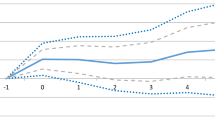Abstract
In this paper we present an interpretation of the economic and financial crisis that considers crucial the issue of income distribution (Krugman 2007; Piketty and Saez 2003; Reynolds 2008), a question that is instead ignored by more widespread interpretations. In fact, we ask what lies behind the disaster of the subprime loans and, if a more thorough view is taken, it seems clear that the true causes of the crisis lead back to income distribution, in other words the enormous increase in the gap between rich and poor. This consideration is fundamental. If the crisis were merely financial then (perhaps) the policies of financial adjustment that are currently in place might be sufficient. If instead the crisis is due to more serious causes, and nothing is more serious than distribution inequalities, then the cure must be much more profound (and difficult). In other words, the crisis will be long and severe until such inequalities are reduced, a difficult task when weighed against public intervention in aid of financial institutions.
Similar content being viewed by others
Notes
In the three-year period between 2002 and 2005 in the US subprime mortgages tripled, going from an overall value of 200 billion dollars to over 600 (INSIDE 2008).
The dates of the US financial crisis are marked by some enormous bankruptcies and severe difficulties for banks and financial institutions. Until mid August 2007 all was well. Towards the end of that month and then in September news began to filter in of a growing number of home repossessions due to unpaid mortgages. On 14th September 2007 the crisis had its first victim, not in the US but in the UK where the government was forced to nationalise Northern Rock, the fifth largest UK institution specialising in mortgages, very exposed in the US market. In December, with the publication of the accounts of the last quarter, it was seen that several banks had drastically devalued their securities, foremostly the Bank of America and Citigroup. In the meantime, the global risk index of financial systems in America and several western countries was growing; hence banks began to reduce credit. On 17th March there came the collapse of Bear Stearns, the largest US investment bank, which was sold to JP Morgan Chase with public intervention at the price of $10 per share (against the $133 stock exchange value of a few months earlier), after JP Morgan’s initial offer of $2 per share. On 10th October, about a year from the start, the global financial crisis was in full swing, with a risk index (Libor-Ois) reaching twenty times that of August 2007 (FRBSL 2008).
It had risen at the end of the 1970s with the oil crisis and had dropped again throughout the 1980s, rising again at the beginning of the 1990 s, but dropping once more in about 1997–1998.
With the opening of a growing gap between house sales prices and building costs, the housing business had begun in the 1980s, but greatly increased from 2000.
When the subscribers abandon a security (a package) because—in our case—it contains 20% of value to reduce to zero, they do not abandon the security in the exact proportion of its real loss of value, which would be 20%, but much more, even though this would in theory be unjustified. The fact is that the subscribers in the market cannot all agree to reduce the demand of that security in the correct proportions. Many more instead abandon it because they believe that others will do the same. This is the reason why the market does not work efficiently except for special cases. This is what Stiglitz has explained in more accurate and complex ways, reasons for which he received the Nobel Prize for Economics.
The rate of return of 10-year treasury bonds, which reached two figures at the beginning of the 1980s then dropped steadily to 4% in 2005.
In fact the degree of debt incurred by American families, which stood constantly at about 12% in the 1960s and 1970s, continued to grow in 1983, in perfect symmetry with the start of the growth of distributive imbalances, and reached almost 24% (hence double) in 2008.
References
BEA (2008) National economic accounts. US Department of Commerce. http://www.bea.gov/newsreleases/national/gdp/gdpnewsrelease.htm
BGFRS (2008) Flow and funds accounts. Board of Governors of the Federal Reserve System. http://www.federalreserve.gov/econresdata/releases/statisticsdata.htm
FRBSL (2008) Economic synopses, n. 25. Federal Reserve Bank of St. Louis
INSIDE (2008) The mortgage market statistical annual. http://www.imfpubs.com/books/
JCHS (2008) The State of the Nation’s Housing 2008. Joint Center for Housing Studies of Harvard University, Havard
Kenworthy L (2009) How much do presidents influence income inequality? Lane Kenworthy’s weblog, February 1
Krugman P (2007) The conscience of a liberal. Norton & Co, New York
OECD (2008) Dataset: income distribution–inequality, November 2008. OECD, Paris
Piketty T, Saez E (2003) Income inequality in the United States 1913–1998. Quart J Econ CXVIII, pp 1–39
RealtyTrac (2008) Foreclosure News Report, various issues. http://www.foreclosurenewsreport.com/About.aspx
Reynolds A (2008) Inequality and taxes. Cato policy report, September/October
Saez E (2008) Striking it richer: the evolution of top incomes in the United States. Working Paper University of California, Department of Economics, 549 Evans Hall #3880, Berkeley, p 94720
Shiller RJ (2005) Irrational exuberance, 2nd edn. Princeton University Press, Princeton
Author information
Authors and Affiliations
Corresponding author
About this article
Cite this article
Pressacco, F., Seravalli, G. The Real Origins of the Global Crisis. Transit Stud Rev 16, 791–801 (2009). https://doi.org/10.1007/s11300-009-0108-8
Received:
Accepted:
Published:
Issue Date:
DOI: https://doi.org/10.1007/s11300-009-0108-8




